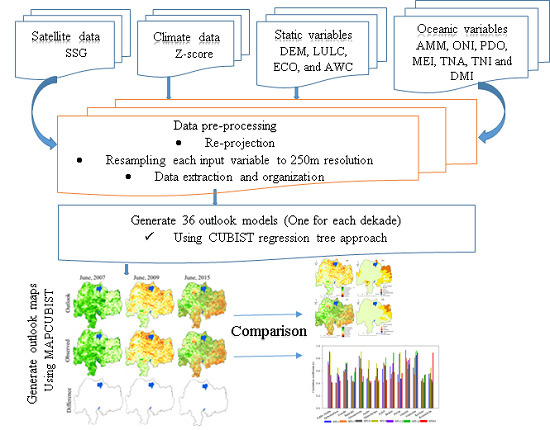Building A High-Resolution Vegetation Outlook Model to Monitor Agricultural Drought for the Upper Blue Nile Basin, Ethiopia
Abstract
1. Introduction
2. Materials and Methods
2.1. Study Area
2.2. Data Used
2.2.1. Climate Data
2.2.2. Satellite Data
- SG is the seasonal greenness,
- P1, P2, …, Pn are dekades within the growing season,
- NDVIp is the observed dekadal value, and
- NDVIb is the baseline NDVI value at the beginning of the growing season.
- is the standardized seasonal greenness for each dekade within the growing season or Z-score of seasonal greenness (SG),
- is the current SG,
- is the average SG observed in the historic record up to time period i, and
- is the standard deviation of the historical values.
2.2.3. Oceanic Indices
2.2.4. Environmental Data
2.2.5. Soil Moisture
2.3. VegOut-UBN Model Development
2.4. VegOut-UBN Map Generation
2.5. Comparison of VegOut-UBN Model with SPI and Food Security Maps
3. Results and Discussions
3.1. VegOut-UBN Model Prediction Accuracy
3.2. Spatial Pattern Correlation
3.3. Spatial Patterns of VegOut-UBN Across the Region
3.4. Comparison Result of VegOut-UBN Model with SPI and Food Security Maps
4. Conclusions
Author Contributions
Funding
Acknowledgments
Conflicts of Interest
References
- Block, S.A. Agriculture and economic growth in Ethiopia: Growth multipliers from a four-sector simulation model. Agric. Econ. 1999, 20, 241–252. [Google Scholar] [CrossRef]
- Diao, X.; Hazell, P.; Thurlow, J. The role of agriculture in African development. World Dev. 2010, 38, 1375–1383. [Google Scholar] [CrossRef]
- IFPRI (International Food Policy Research Institute). Available online: http://www.ifpri.org/blog/ethiopias-2015-drought-no-reason-famine (accessed on 24 June 2017).
- OCHA. Available online: http://reliefweb.int/sites/reliefweb.int/files/resources/START-briefing-Ethiopia-Jan-2016.pdf (accessed on 20 June 2017).
- Viste, E.; Korecha, D.; Sorteberg, A. Recent drought and precipitation tendencies in Ethiopia. Theor. Appl. Climatol. 2013, 112, 535–551. [Google Scholar] [CrossRef]
- Bayissa, Y.; Semu, A.; Yunqing, X.; Schalk, A.; Shreedhar, M.; Dimitri, S.; Griensven, A.; Tadesse, T. Spatio-temporal assessment of meteorological drought under the influence of varying record length: The case of Upper Blue Nile Basin, Ethiopia. Hydrol. Sci. J. 2015, 60, 1927–1942. [Google Scholar] [CrossRef]
- Tadesse, T.; Wardlow, B.D.; Svoboda, M.D.; Hayes, M.J. Vegetation Outlook (VegOut): Predicting Remote Sensing–Based Seasonal Greenness. In Remote Sensing of Drought: Innovative Monitoring Approaches; CRC Press: Boca Raton, FL, USA, 2012. [Google Scholar]
- Verdin, J.; Klaver, R. Grid-cell-based crop water accounting for the famine early warning system. Hydrol. Process 2002, 16, 1617–1630. [Google Scholar] [CrossRef]
- Funk, C.; Peterson, P.; Landsfeld, M.; Pedreros, D.; Verdin, J.; Rowland, J.; Romero, B.; Husak, G.; Michaelsen, J.; Verdin, A.; et al. A Quasi-Global Precipitation Time Series for Drought Monitoring. US Geol. Surv. Data Ser. 2014, 832. [Google Scholar] [CrossRef]
- Ji, L.; Peters, A.J. Assessing vegetation response to drought in the northern Great Plains using vegetation and drought indices. Remote Sens. Environ. 2003, 87, 85–98. [Google Scholar] [CrossRef]
- Liu, W.T.; Kogan, F.N. Monitoring regional drought using the vegetation condition index. Int. J. Remote Sens. 1996, 17, 2761–2782. [Google Scholar] [CrossRef]
- Westphal, C.; Blaxton, T. Data Mining Solutions: Methods and Tools for Solving Real-World Problems; John Wiley & Sons: New York, NY, USA, 1998. [Google Scholar]
- Brown, J.F.; Wardlow, B.D.; Tadesse, T.; Hayes, M.J.; Reed, B.C. The vegetation drought response index (VegDRI): A new integrated approach for monitoring drought stress in vegetation. GISci. Remote Sens. 2008, 45, 16–46. [Google Scholar] [CrossRef]
- Seleshi, Y.; Demaree, G.R. Rainfall variability in the Ethiopian and Eritrean highlands and its links with the Southern Oscillation Index. J. Biogeogr. 1995, 2, 945–952. [Google Scholar] [CrossRef]
- Bayissa, Y.; Tadesse, T.; Demisse, G.; Shiferaw, A. Evaluation of satellite-based rainfall estimates and application to monitor meteorological drought for the Upper Blue Nile Basin, Ethiopia. Remote Sens. 2017, 9, 669. [Google Scholar] [CrossRef]
- AghaKouchak, A.; Farahmand, A.; Melton, F.S.; Teixeira, J.; Anderson, M.C.; Wardlow, B.D.; Hain, C.R. Remote sensing of drought: Progress, challenges and opportunities. Rev. Geophys. 2015, 53, 452–480. [Google Scholar] [CrossRef]
- Tucker, C.J.; Choudhury, B.J. Satellite remote sensing of drought conditions. Remote Sens. Environ. 1987, 23, 243–251. [Google Scholar] [CrossRef]
- Han, J.; Pei, J.; Kamber, M. Data Mining: Concepts and Techniques; Elsevier: Amsterdam, The Netherlands, 2011. [Google Scholar]
- Zheng, H.; Chen, L.; Han, X.; Zhao, X.; Ma, Y. Classification and regression tree (CART) for analysis of soybean yield variability among fields in Northeast China: The importance of phosphorus application rates under drought conditions. Agric. Ecosyst. Environ. 2009, 132, 98–105. [Google Scholar] [CrossRef]
- Tadesse, T.; Wilhite, D.A.; Hayes, M.J.; Harms, S.K.; Goddard, S. Discovering associations between climatic and oceanic parameters to monitor drought in Nebraska using data-mining techniques. J. Clim. 2005, 18, 1541–1550. [Google Scholar] [CrossRef]
- Tadesse, T.; Wardlow, B.D.; Hayes, M.J.; Svoboda, M.D.; Brown, J.F. The Vegetation Outlook (VegOut): A new method for predicting vegetation seasonal greenness. GISci. Remote Sens. 2010, 47, 25–52. [Google Scholar] [CrossRef]
- Tadesse, T.; Demisse, G.B.; Zaitchik, B.; Dinku, T. Satellite-based hybrid drought monitoring tool for prediction of vegetation condition in Eastern Africa: A case study for Ethiopia. Water Resour. Res. 2014, 50, 2176–2190. [Google Scholar] [CrossRef]
- Tadesse, T.; Wilhite, D.A.; Harms, S.K.; Hayes, M.J.; Goddard, S. Drought monitoring using data mining techniques: A case study for Nebraska, USA. Nat. Hazards 2004, 33, 137–159. [Google Scholar] [CrossRef]
- Panda, S.S.; Ames, D.P.; Panigrahi, S. Application of vegetation indices for agricultural crop yield prediction using neural network techniques. Remote Sens. 2010, 2, 673–696. [Google Scholar] [CrossRef]
- Tadesse, T.; Champagne, C.; Wardlow, B.D.; Hadwen, T.A.; Brown, J.F.; Demisse, G.B.; Bayissa, Y.A.; Davidson, A.M. Building the vegetation drought response index for Canada (VegDRI-Canada) to monitor agricultural drought: First results. GISci. Remote Sens. 2017, 54, 230–257. [Google Scholar] [CrossRef]
- Chen, C.S.; Chen, W.C.; Chen, Y.L.; Lin, P.L.; Lai, H.C. Investigation of orographic effects on two heavy rainfall events over southwestern Taiwan during the Mei-yu season. Atmos. Res. 2005, 73, 101–130. [Google Scholar] [CrossRef]
- Conway, D. The climate and hydrology of the Upper Blue Nile River. Geogr. J. 2000, 166, 49–62. [Google Scholar] [CrossRef]
- Kebede, S.; Travi, Y.; Alemayehu, T.; Marc, V. Water balance of Lake Tana and its sensitivity to fluctuations in rainfall, Blue Nile basin, Ethiopia. J. Hydrol. 2006, 316, 233–247. [Google Scholar] [CrossRef]
- Yilma, A.D.; Awulachew, S.B. Characterization and atlas of the Blue Nile Basin and its sub basins. In Proceedings of the International Water Management Institute (IWMI), Colombo, Sri Lanka, 5–6 February 2009. [Google Scholar]
- Mellander, P.E.; Gebrehiwot, S.G.; Gärdenäs, A.I.; Bewket, W.; Bishop, K. Summer rains and dry seasons in the Upper Blue Nile Basin: The predictability of half a century of past and future spatiotemporal patterns. PLoS ONE 2013, 8, e68461. [Google Scholar] [CrossRef] [PubMed]
- Degefu, M.A.; Rowell, D.P.; Bewket, W. Teleconnections between Ethiopian rainfall variability and global SSTs: Observations and methods for model evaluation. Meteorol. Atmos. Phys. 2017, 129, 173–186. [Google Scholar] [CrossRef]
- Tekleab, S.; Mohamed, Y.; Uhlenbrook, S. Hydro-climatic trends in the Abay/Upper Blue Nile basin, Ethiopia. Phys. Chem. Earth Parts A/B/C 2013, 61, 32–42. [Google Scholar] [CrossRef]
- TECSULT: Ethiopian Energy II Project. Woody Biomass Inventory and Strategic Project (WBISPP)–Phase 2 –Terminal Report; Ministry of Agriculture: Addis Ababa, Ethiopia, 2004.
- Betrie, G.D.; Mohamed, Y.A.; van Griensven, A.; Srinivasan, R. Sediment management modelling in the Blue Nile Basin using SWAT model. Hydrol. Earth Syst. Sci. 2011, 15, 807–818. [Google Scholar] [CrossRef]
- McKee, T.B.; Doesken, N.J.; Kleist, J.; American Meteorological Society. Drought monitoring with multiple time scales. In Proceedings of the 9th Conference on Applied Climatology, Dallas, TX, USA, 15–20 January 1995; pp. 233–236. [Google Scholar]
- Gissila, T.; Black, E.; Grimes, D.I.F.; Slingo, J.M. Seasonal forecasting of the Ethiopian summer rains. Int. J. Climatol. 2004, 24, 1345–1358. [Google Scholar] [CrossRef]
- Korecha, D.; Barnston, A.G. Predictability of June–September rainfall in Ethiopia. Mon. Weather. Rev. 2007, 135, 628–650. [Google Scholar] [CrossRef]
- Camberlin, P.; Janicot, S.; Poccard, I. Seasonality and atmospheric dynamics of the teleconnection between African rainfall and tropical sea-surface temperature: Atlantic vs. ENSO. Int. J. Climatol. 2001, 21, 973–1005. [Google Scholar] [CrossRef]
- Degefu, W. Some aspects of meteorological droughts in Ethiopia. In Drought Hunger in Africa; Glantz, M.H., Ed.; Cambridge University Press: Cambridge, UK, 1987; pp. 23–36. [Google Scholar]
- ESRL. Available online: https://www.esrl.noaa.gov/psd/data/climateindices/list/ (accessed on 23 June 2017).
- Batjes, N.H. Harmonized soil profile data for applications at global and continental scales: Updates to the WISE database. Soil Use Manag. 2009, 25, 124–127. [Google Scholar] [CrossRef]
- Xia, Y.; Ek, M.B.; Wu, Y.; Ford, T.; Quiring, S.M. Comparison of NLDAS-2 simulated and NASMD observed daily soil moisture. Part I: Comparison and analysis. J. Hydrometeorol. 2015, 16, 1962–1980. [Google Scholar] [CrossRef]
- Rulequest. An Overview of Cubist; RuleQuest Research Pty Ltd.: St Ives, NSW, Australia, 2013; Available online: https://www.rulequest.com/cubist-win.html (accessed on 20 June 2017).
- Rajput, A.; Soni, R.; Aharwal, R.P.; Sharma, R. Impact of data mining in drought monitoring. IJCSI Int. J. Comput. Sci. 2011, 6, 309. [Google Scholar]
- McKee, T.B.; Doesken, N.J.; Kleist, J. The relationship of drought frequency and duration to time scales. In Proceedings of the 8th Conference on Applied Climatology, Anaheim, CA, USA, 17–22 January 1993; pp. 179–184. [Google Scholar]
- Bayissa, Y.A.; Tadesse, T.; Svoboda, M.; Wardlow, B.; Poulsen, C.; Swigart, J.; Van Andel, S.J. Developing a satellite-based combined drought indicator to monitor agricultural drought: A case study for Ethiopia. GISci. Remote Sens. 2018, 1–31. [Google Scholar] [CrossRef]
- Bayissa, Y.A.; Maskey, S.; Tadesse, T.; van Andel, S.J.; Moges, S.; van Griensven, A.; Solomatine, D. Comparison of the performance of six drought índices in characterizing historical drought for the Upper Blue Nile Basin, Ethiopia. Geosciences 2018, 8, 81. [Google Scholar] [CrossRef]
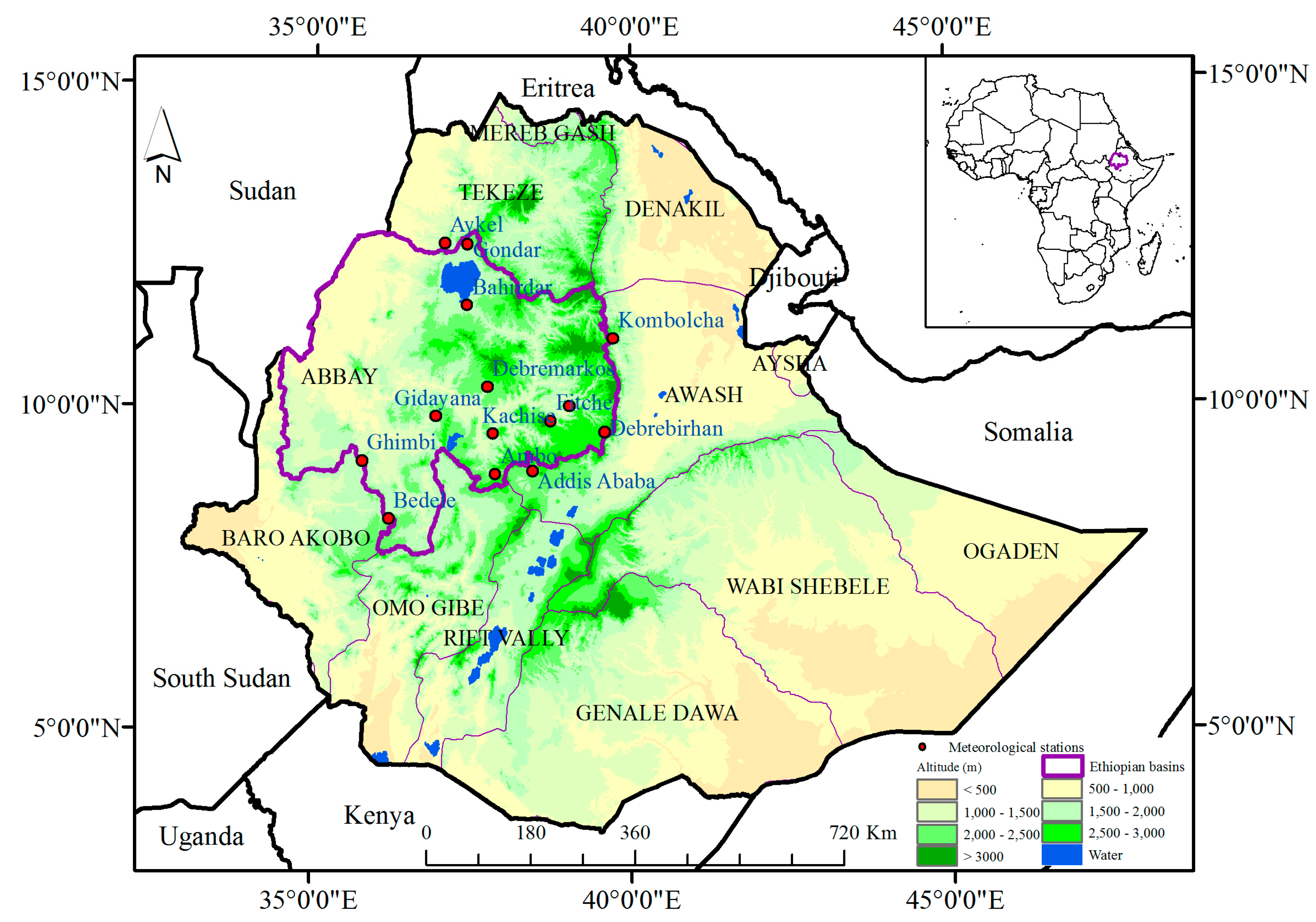

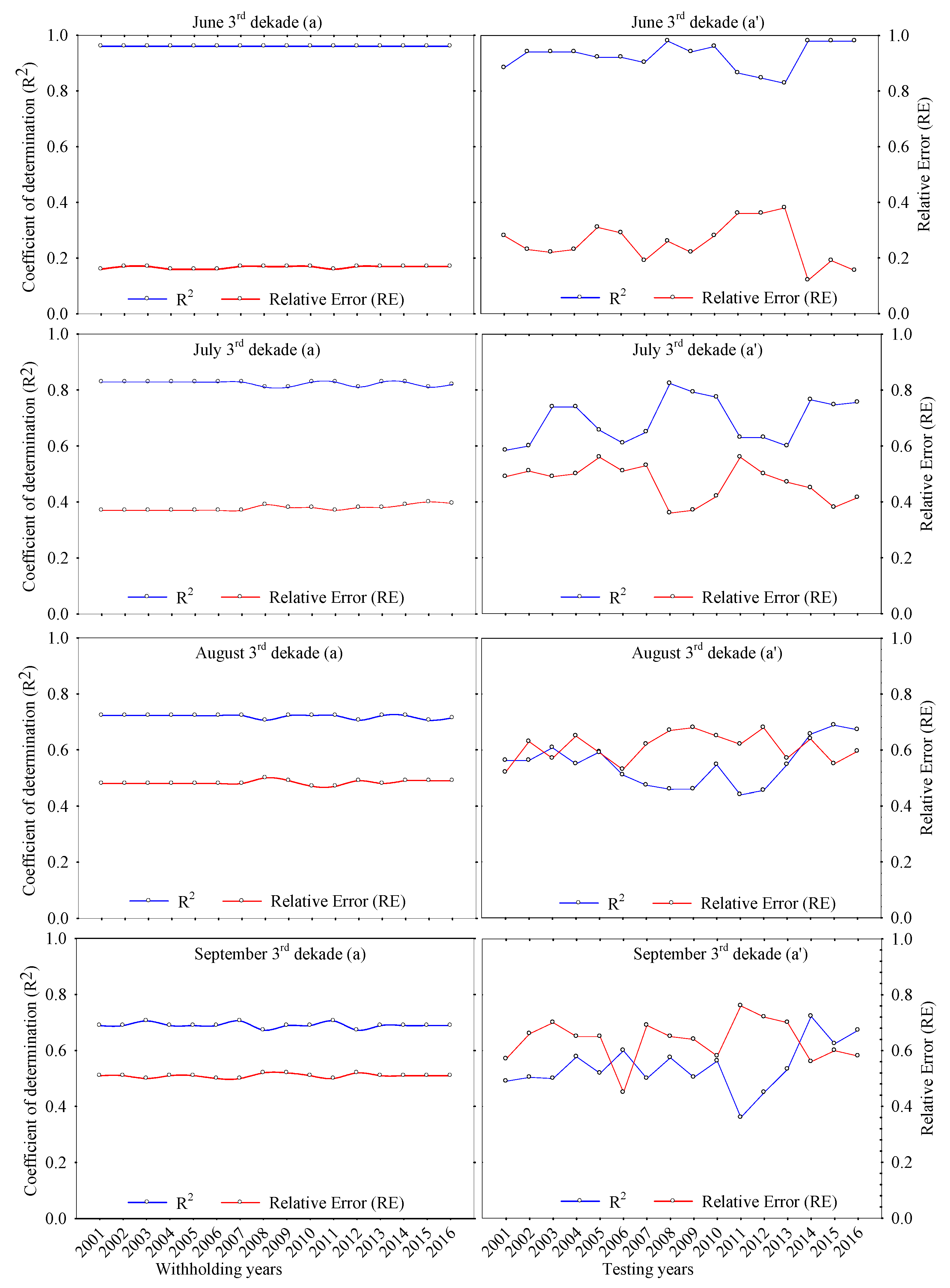
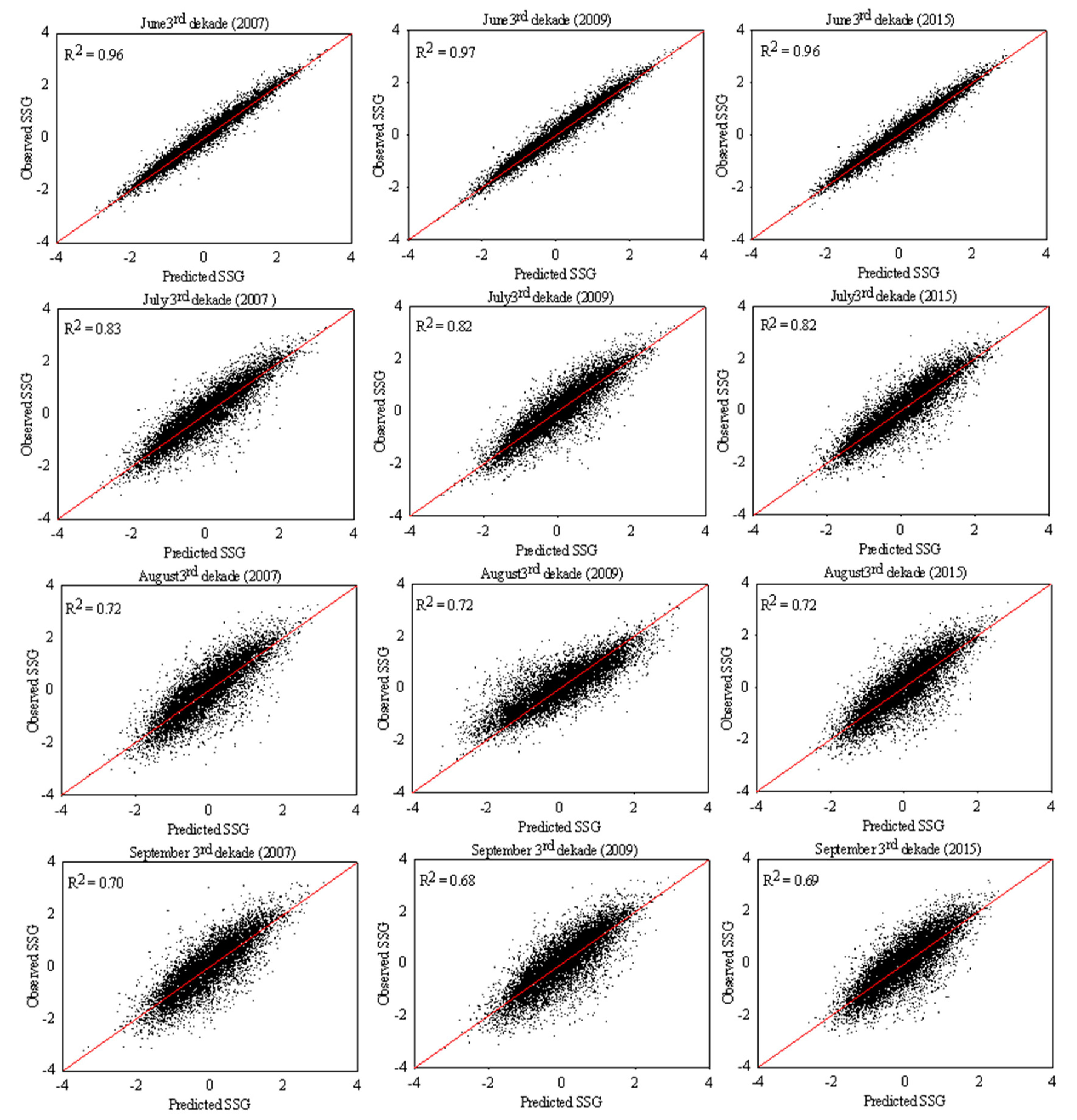
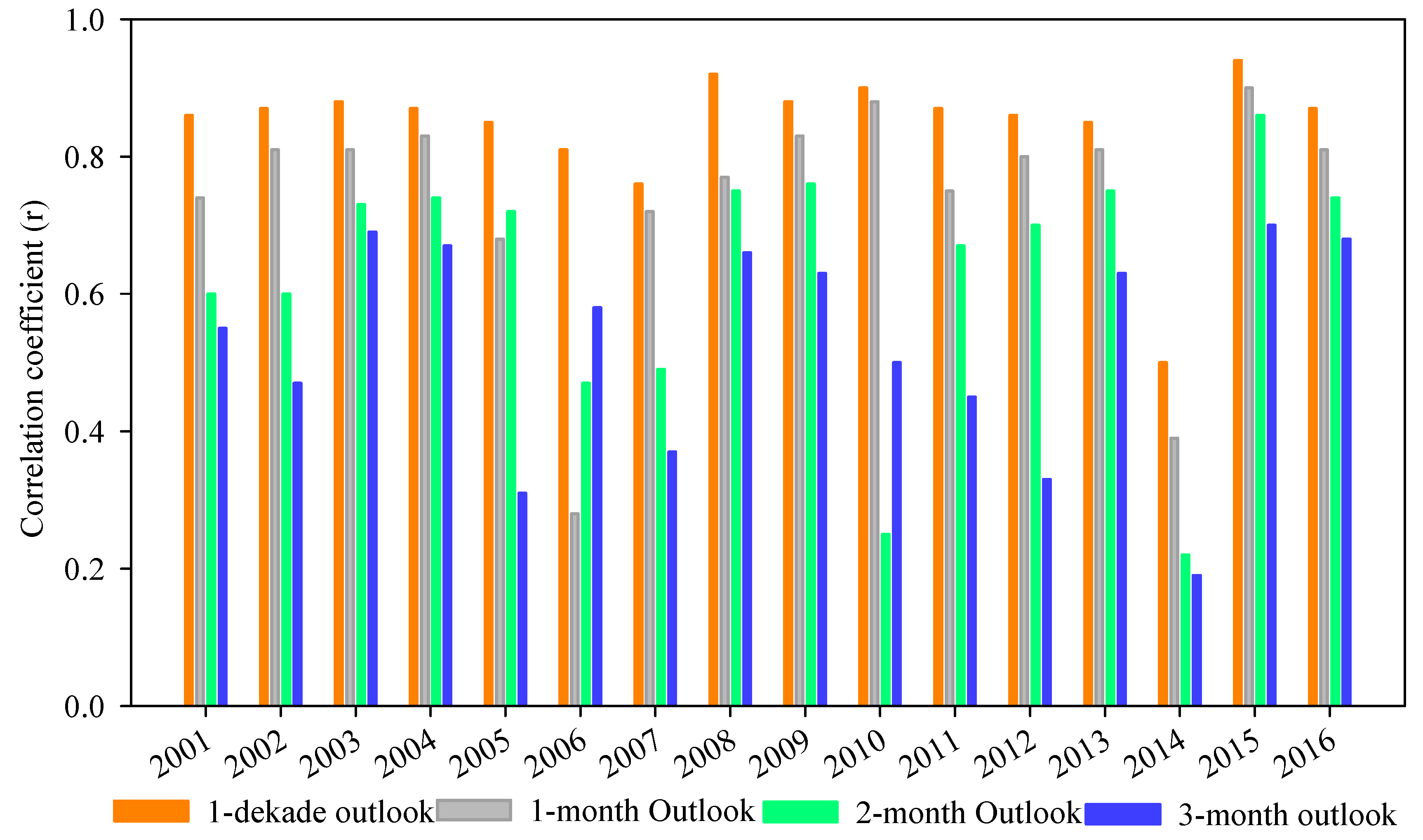
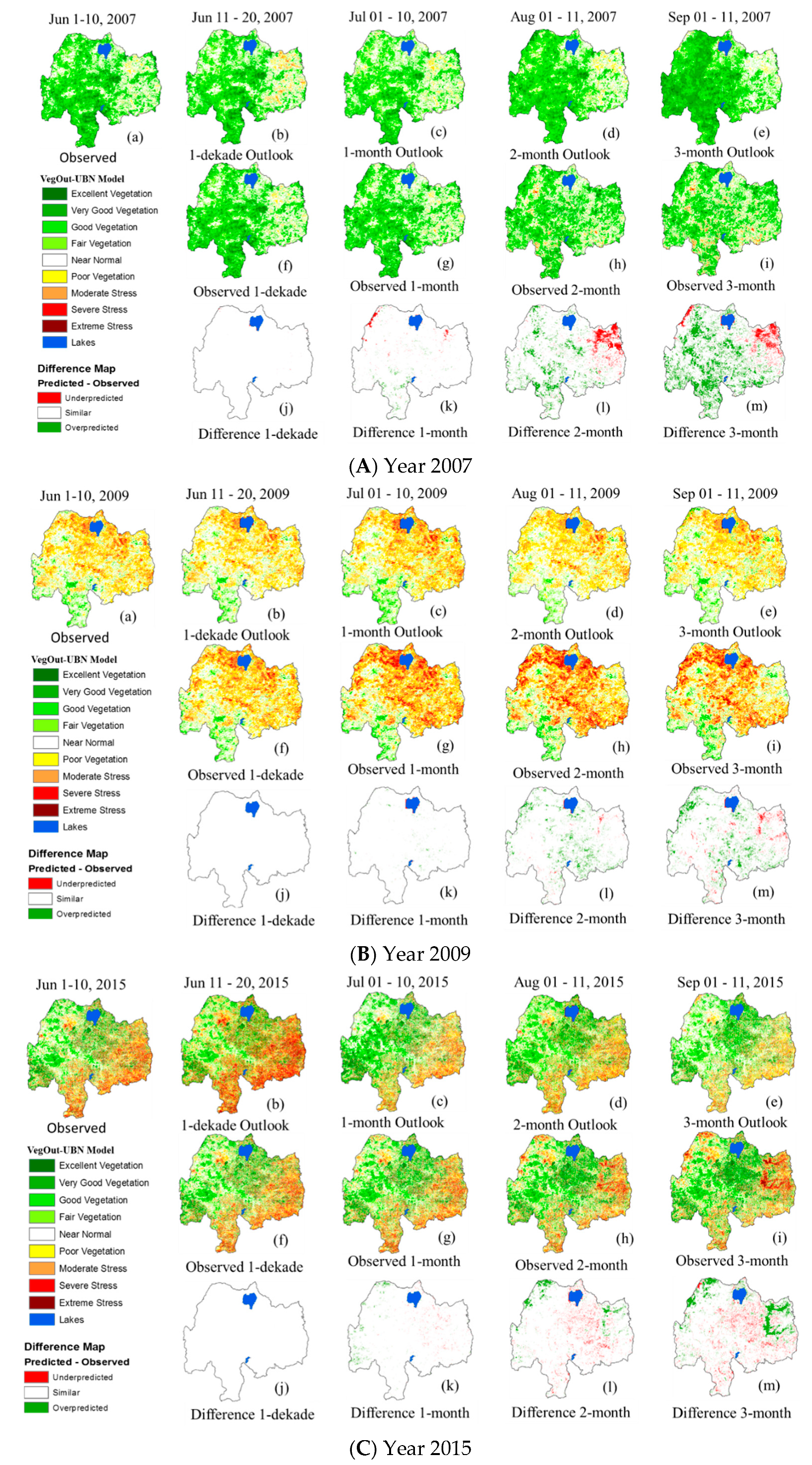
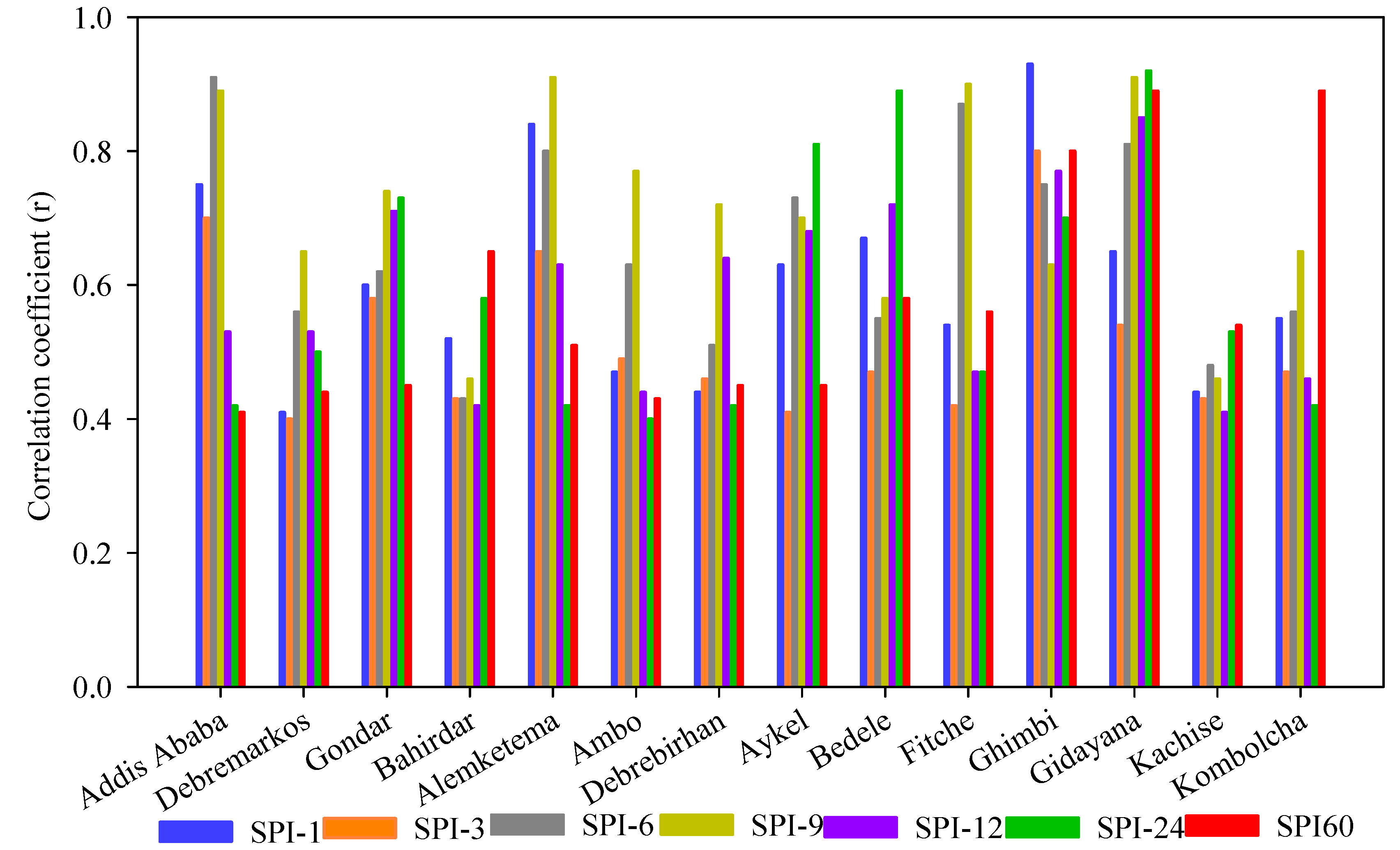
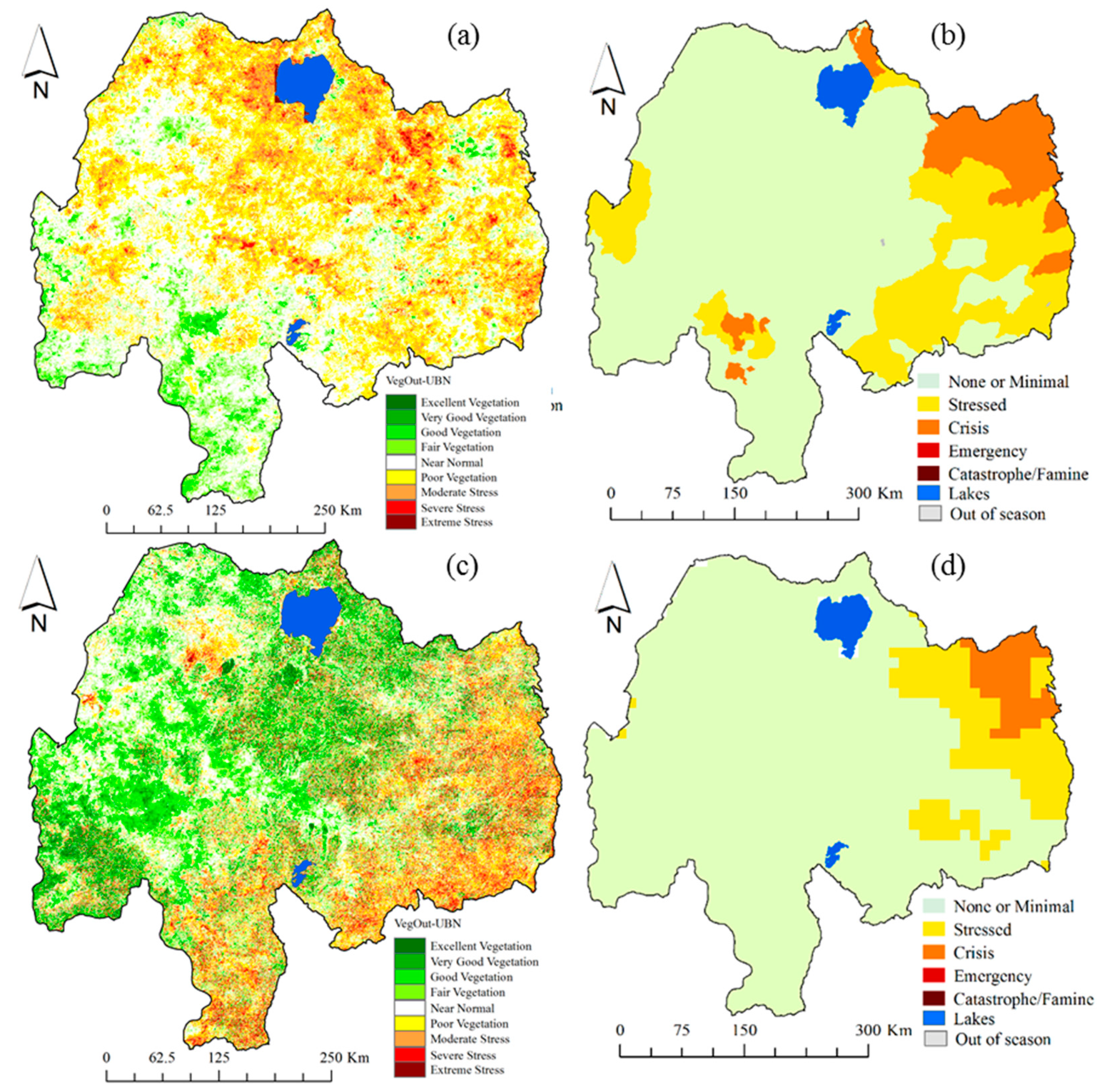
| No. | Attributes | Resolutions | Source | |
|---|---|---|---|---|
| Spatial | Temporal | |||
| 1 | NDVI-based standardized seasonal greenness (SSG) | 250 m | dekadal | eMODIS |
| 2 | CHIRPS rainfall | 5 km | dekadal | CHG |
| 3 | Atlantic Meridional Mode (AMM) | - | monthly | CPC/NOAA |
| 4 | Multivariate ENSO index (MEI) | - | monthly | CPC/NOAA |
| 5 | Oceanic Niño Index (ONI) | - | monthly | CPC/NOAA |
| 6 | Pacific Decadal Oscillation (PDO) | - | monthly | CPC/NOAA |
| 7 | Tropical Northern Atlantic Index (TNA) | - | monthly | CPC/NOAA |
| 8 | Trans- Niño Index (TNI) | - | monthly | CPC/NOAA |
| 9 | Dipole Mode Index (DMI) | - | monthly | CPC/NOAA |
| 10 | Digital Elevation Model (DEM) | 90 m | - | SRTM |
| 11 | Land use/Land cover (LULC) | 300 m | - | ESA |
| 12 | Available Water Holding Capacity (AWC) | 1 km | - | ISRIC-WISE |
| 13 | Ecosystem type (eco) | 1 km | - | Ecodiv.org |
| 14 | Soil moisture | 10 km | monthly | FEWS NET |
| VegOut-UBN Values | Drought Category |
|---|---|
| −2.00 and less | Extreme Stress |
| −1.50 to −1.99 | Severe Stress |
| −1.00 to −1.49 | Moderate Stress |
| −0.5 to −0.99 | Poor Vegetation |
| −0.5 to 0.5 | Near Normal |
| 0.5 to 0.99 | Fair Vegetation |
| 1.0 to 1.49 | Good Vegetation |
| 1.5 to 1.99 | Very Good Vegetation |
| >2.0 | Excellent Vegetation |
| PHASE 1 Minimal | More than four in five households (HHs) are able to meet essential food and nonfood needs without engaging in atypical, unsustainable strategies to access food and income. |
| PHASE 2 Stressed | Even with any humanitarian assistance at least one in five HHs in the area have the following or worse: minimally adequate food consumption but are unable to afford some essential nonfood expenditures without engaging in irreversible coping strategies. |
| PHASE 3 Crises | Even with any humanitarian assistance at least one in five HHs in the area have the following or worse: Food consumption gaps with high or above usual acute malnutrition OR Are marginally able to meet minimum food needs only with accelerated depletion of livelihood assets that will lead to food consumption gaps. |
| PHASE 4 Emergency | Even with any humanitarian assistance at least one in five HHs in the area have the following or worse: Large food consumption gaps resulting in very high acute malnutrition and excess mortality OR Extreme loss of livelihood assets that will lead to food consumption gaps in the short term. |
| PHASE 5 Famine | Even with any humanitarian assistance at least one in five HHs in the area have an extreme lack of food and other basic needs where starvation, death, and destitution are evident. Evidence for all three criteria (food consumption, acute malnutrition, and mortality) is required to classify Famine. |
| Food Security Status | Average VegOut-UBN Values | |
|---|---|---|
| 2009 | 2015 | |
| None or Minimal | −0.23 | 0.14 |
| Stressed | −0.41 | −0.31 |
| Crisis | −0.54 | −0.39 |
© 2019 by the authors. Licensee MDPI, Basel, Switzerland. This article is an open access article distributed under the terms and conditions of the Creative Commons Attribution (CC BY) license (http://creativecommons.org/licenses/by/4.0/).
Share and Cite
Bayissa, Y.; Tadesse, T.; Demisse, G. Building A High-Resolution Vegetation Outlook Model to Monitor Agricultural Drought for the Upper Blue Nile Basin, Ethiopia. Remote Sens. 2019, 11, 371. https://doi.org/10.3390/rs11040371
Bayissa Y, Tadesse T, Demisse G. Building A High-Resolution Vegetation Outlook Model to Monitor Agricultural Drought for the Upper Blue Nile Basin, Ethiopia. Remote Sensing. 2019; 11(4):371. https://doi.org/10.3390/rs11040371
Chicago/Turabian StyleBayissa, Yared, Tsegaye Tadesse, and Getachew Demisse. 2019. "Building A High-Resolution Vegetation Outlook Model to Monitor Agricultural Drought for the Upper Blue Nile Basin, Ethiopia" Remote Sensing 11, no. 4: 371. https://doi.org/10.3390/rs11040371
APA StyleBayissa, Y., Tadesse, T., & Demisse, G. (2019). Building A High-Resolution Vegetation Outlook Model to Monitor Agricultural Drought for the Upper Blue Nile Basin, Ethiopia. Remote Sensing, 11(4), 371. https://doi.org/10.3390/rs11040371






